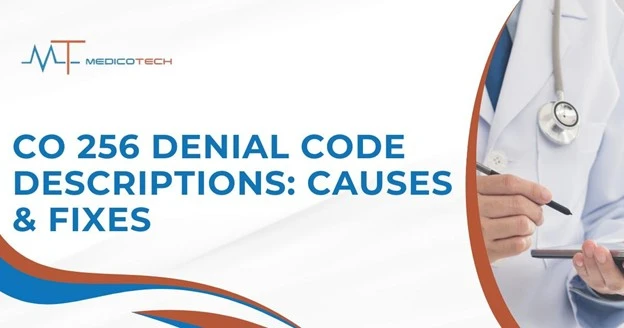Insurance denials are frustrating, and that can be all the more so when you’re dealing with life giving services or medications. A code denial that is often used, or abused, by payers is PR 204 indicating that the patient’s insurance does not cover the service or medication provided. We must understand why this occurs, and how to fix it cost effectively so as to limit the financial impact on both the provider and patient. Here we’ll cover what PR 204 is, the reasons for it and how to address it in a manner that works out well for everyone.
Overview of PR 204 Denial Code
PR 204 denial code in Medical billing is used to notify the denied claims which are not covered under the particular payer/contract. When this happens, the burden of payment shifts to the patient, not the insurance. Healthcare providers need to be educated on PR 204 as it has clinical and financial influence on the revenue cycle and patient satisfaction. Understanding the etiology and treatment of such cases allows you to respond better to these situations and minimize potential economic burden both on your practice and on the patient.
Significance of Knowing About and Dealing With Denial
Successful resolution of PR 204 denials is important both for proper billing flow and to avoid financial responsibility for patients. When there is a denial such as PR 204, it comes across that the patient may be liable for the service and can cause patients to be confused or upset. For providers, expeditious resolution of these denials is essential for business operations and operational efficiency (cash flow next to quality documentation). Also teaching patients benefit responsibility and providing payment plan options often drastically increases patient experience and retention.
What is PR 204 Denial Code?
Definition and Meaning
PR 204 is an insurance denial code that means the service, medicine or device used isn’t covered under that patient’s current insurance plan. This usually occurs if the insurance has exclusions, the patient’s provider is out of network or required prior authorization for a service was not obtained. In other words, this code informs doctors that the insurance company will not pay for the service and that the patient must do so instead.
Explanation of Financial Responsibility
A PR 204 denial results in the patient being responsible for payment of the service or drug. A variety of reasons might account for this, including non coverage under their plan, out of network provider disputes or the absence of prior authorization. Therefore, a charge will be made according to the regular fee of the physician, or some other type of agreement concerning payment must be made with the patient. This can be a surprise to patients, highlighting the need for healthcare providers to clearly and quickly notify them of their insurance coverage status, as well as any out of pocket costs.
Causes of PR 204 denial code
Service Not Covered
A PR 204 claim denial occurs frequently when the service, drug or supply is not a covered benefit of the patient’s insurance plan. This is possibly explained by exclusions under the policy, which could include experimental treatments or cosmetic procedures. If so, the service is carried out by a provider but not paid for by the insurance company, and the patient gets stuck with the bill. It is important to verify what is covered under a patient’s insurance policy before rendering non essential services to avoid these types of denials.
Out of Network Provider
Another ground for the denial of PR 204 would be when a non contracted provider renders the service to insured. If the patient is treated by a provider that does not participate in their health insurance plan’s network, the service may be covered at all, or only partially. In which, the patient is liable for the outstanding amount. Providers either need to be in the patient’s insurance network or must alert the patient before a visit that they may incur out of pocket costs if they go outside their own network for care.
Lack of Prior Authorization
Some services must be authorized in advance by the insurer before they’re provided. If the consent id is not obtained, insurance may deny with PR 204. Examples are elective surgery, specialized care, and costly drugs. The health facility must make certain that any and all service that necessitates preapproval is presented to the insurance company ahead of time. If one does not, the patient is responsible for the bill costs that could be fiscally oppressive.
Policy Limitations
Insurance is therapeutic but there may be limits on what a given policy will cover, such as services or medications. Limitations may be the number of treatments, a maximum amount (measured in dollars) that can be reimbursed, or exclusions for either specific procedures or even types of treatments. For instance, some policies won’t cover experimental treatments or cosmetic procedures that are not urgent. If the benefit falls into one of these categories, the payer may deny as a PR 204 denial, wherein the patient is held liable for payment of service.
How to fix PR 204 denial code
When you receive the denial code PR 204 it’s critical that you adhere to a clear, effective process to resolve it as quickly as possible. Clearing this rejection will require checking to confirm the patient’s benefits, obtaining prior authorization (if required), discussing the denial with the payer and providing alternative methods of payment. We break down each step below to help you navigate the resolution.
Verify Patient Benefits
Checking patient insurance benefits is the first step in addressing a denial related to PR 204. Perform thorough insurance verification with the insurer, prior to service, to confirm which services are included in the patient’s plan. This confirmation will flush out any surprises at billing time and prevent you from paying for services not covered. It’s key to inquire about exclusions, limitations and whether the service needs pre authorization. If there is any doubt, written clarification from the insurance company can be useful in case of disagreement.
Check for Authorization
Some, particularly nonemergent or specialized services, need pre approval from the insurer. If the denial for PR 204 is a result of no prior authorization, you must obtain the prior auth to determine if such authorization was obtained before rendering service. If it was not, then the physician would proceed with filing a preauthorization request with the insurer. Some insurers will let you appeal the denial by sending in the prior authorization documentation after service, so it’s worth clarifying if your insurer has a policy on that.
Discuss the Denial with the Payer
After you’ve confirmed patient benefits and whether authorization was obtained, the next step is to reach out to the insurance payer directly to initiate review of your denial. Ask for a specific determination after discussing why the claim was denied. There might be an error or even oversight in the insurance company’s examination process. If the denial was due to a policy exclusion or out of network situation, talk through options with the insurer. It can be useful to have a record of what benefits the patient’s plan covers, and what service was provided. to prove your case that the denial should be overturned.
Offer Alternative Payment Options
If the denial is upheld, and the patient is financially responsible, it’s important to present other payment options so as to reduce financial angst. You can offer a payment plan, cash discount or collaborate with third party financing companies who let patients pay in installments. Clear exchange of information about what they are financially responsible for, and giving them options to pay the bill in a way that makes sense to them can help keep things on proper terms and reduce delays.
Measures for Prevention of Future PR 204 Denials
Although it may not always be possible to avoid PR 204 denials, there are a number of measures that can help minimize the chances of them happening in the future.
Importance of Pre Authorization
One of the surefire ways to stymie those PR 204 denials and related non covered charge issues like the PR 96 is by getting pre authorization before you treat. Pre approval for specific tests, medication or supplies may be required under your insurance plan. It’s important to reassess the patient’s benefit plan and determine whether pre authorization is required. You may prevent such unnecessary denials, and ensure you receive something if the insurance company does get involved. Review the specifics and timing for requesting authorizations to avoid last minute issues.
Provider Network Considerations
Another common PR 204 denial is related to out of network provider problems. To avoid such denials, it’s more important than ever to verify that your practice or service is in network with the patient’s insurance or let patients know when they’re seeing an out of network provider. For patients who want care out of network, provide them with an understandable description of what they will be on the hook for and if there are financial aid options available. If you can, negotiate with insurers to get into their network now so that future coverage is not a problem.
Keeping Track of Insurance Policy Limitations
Knowing areas of exclusions and limitations for policies also can prevent future PR 204 denials. Most insurance policies have some kind of restrictions on what’s covered, like elective injuries, experimental treatments or out of network care. By recording what these limitations are and teaching your patients about the same, you can make sure that you do not provide services that are not reimbursable under the terms of their contract. This is the reason that it is important to consistently read through insurance contracts and keep up with policy updates so you know what services are covered but not reimbursed.
Final Summary
The denial code PR 204 represents Medicare saying the patient’s insurance plan does not cover a particular service, medication or device and this responsibility is transferred to the patient. Cores steps in combating this denial include verifying patient coverage, confirming prior authorization status, meeting with the payer to discuss the denial and providing second chance payment methods. To prevent future denials, providers should focus on pre authorisation where necessary and provider network when they come to select insurance, keep them updated with policy terms and limitations
Knowing how to handle PR 204 denials is important for both providers and patients. You can resolve it effectively by confirming benefits and authorization, discussing the denial with the payer, and presenting payment options while still maintaining positive relationships with your patients. Avoiding future PR 204 denials requires being proactive by pre authorizing, checking network coverage, and keeping up with insurance policy specifics.
FAQs
What is PR 204?
PR 204 Patient is financially liable when a service, drug or device is non covered under the patient’s insurance coverage.
Why am I getting a PR 204 deny?
PR 204 denial reasons are usually related to service exclusions, out of network provider, no prior authorization and policy incoverage.
What could I do to prevent PR 204 denials?
In order to prevent further PR 204 denials, be sure that the pre authorization is in place, verify the services are covered under patient’s network agreement, and stay informed on what specific insurance policies cover.
If a PR 204 denial is received, what should I do?
For a PR 204 denial, confirm the patient’s benefits and ask if there is prior authorization on file; speak with the payer about the denial, and consider other payment options for the patient.
How to fix pr 204 denial?
To address the denial, consider reviewing the patient’s insurance plan, requesting prior authorization if necessary, contacting the payer to discuss any issues with them and keep reaching out to resolve it with both your clinic staff and patients by providing payment arrangements.




